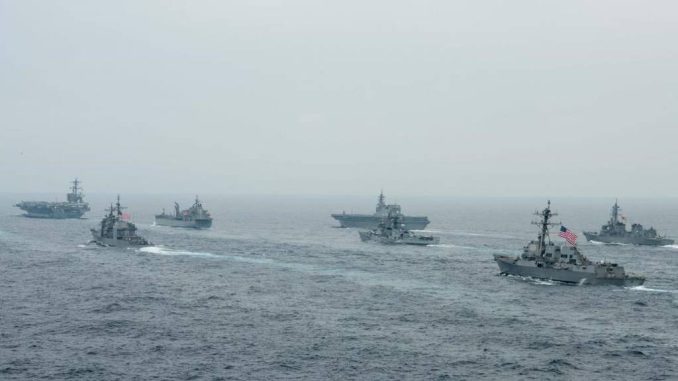
Phase two of Exercise MALABAR 2021 kicked off Oct. 11 in the Bay of Bengal, with naval forces participating from Australia, Japan, India and the United States.
The annual maritime exercise, hosted by the U.S. Navy, is comprised of a variety of high-end tactical training events designed to strengthen interoperability between the Royal Australian Navy, Japan Maritime Self Defense Force (JMSDF), Indian Navy and U.S. maritime forces in the Indo-Pacific region, according to the Navy.
The second phase of MALABAR will be comprised of a surface and air expendable mobile anti-submarine warfare training target exercise, a surface gunnery exercise and cross-deck helicopter operations.
“MALABAR 21 improves the compatibility of our forces in support of our mutual desire for unmatched maritime security in the global commons,” Rear. Adm. Dan Martin, commander of Carrier Strike Group 1, said in a Navy press release.
“Unit integration during complex task group maneuvers further demonstrates our ability to effectively work with our Indo-Pacific allies and partners and win in any contested maritime environment.”
The first phase of MALABAR kicked off in August and included live-fire gunnery events, air warfare operations, anti-submarine warfare operations, and maritime interdiction operations in the Philippine Sea.
Phase two is being conducted in the Bay of Bengal in order to facilitate participating forces to train in two different regions in the Indo-Pacific.
Carrier Strike Group 1—aircraft carrier Carl Vinson, Carrier Air Wing 2, Ticonderoga-class guided-missile cruiser Lake Champlain, Arleigh Burke-class guided-missile destroyer Stockdale, and a P-8A Poseidon maritime patrol and reconnaissance aircraft are all representing the U.S. Navy in the exercise.
Royal Australian Navy participants included Anzac-class frigate HMAS Ballarat and HMAS Sirius.
“Close cooperation with key partners with India, Japan, and the United States fosters our professional mariner relationships and enhance our interoperability,” Cmdr. Antony Pisani, commanding officer of HMAS Ballarat said in the press release.
Representing the Indian Navy is Rajput-class guided-missile destroyer INS Ranvijay, Shivalik-class multi-role stealth frigate INS Satpura, and a P-8I maritime patrol and reconnaissance aircraft.
JMSDF participants include Izumo-class multipurpose operation destroyer JS Kaga, Murasame-class destroyers JS Murasame.
U. S. Pacific Fleet, 7th Fleet, routinely interacts with more than 35 maritime nations in the Indo-Pacific region and is the U.S. Navy’s largest forward-deployed numbered fleet.
Rachel is a Marine Corps veteran and Master’s candidate at New York University. She’s currently an Editorial Fellow for Military Times.



Be the first to comment